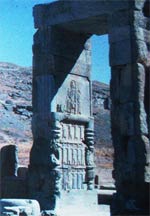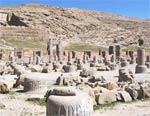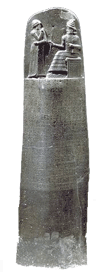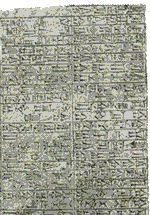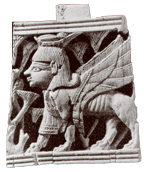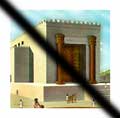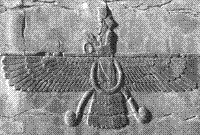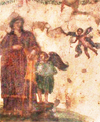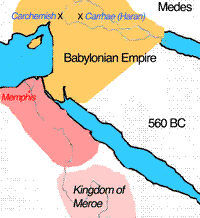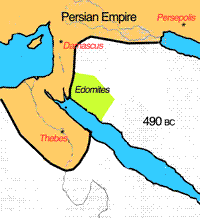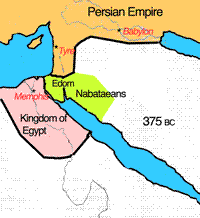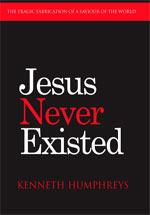Where are the Jews?
Persepolis gateway to the Hall of a Hundred Columns.
Beneath a seated Xerxes (486-465 BC), 3 rows of figures represent the peoples of the Persian Empire:
Elamite, Armenian, Lydian, Assyrian, Egyptian, Ionian, Gandaran, Sagartian, Sogdian, Skudra, Arab and Scythian.
Jews are nowhere in sight.
Hall of Pillars
1 Kings 7.6 gives the mythical Solomon a "Hall of Pillars" in Jerusalem.
The reality can still be seen – in Persepolis (Iran).
Fictional Kingdom
"The kingdom of Israel is not mentioned in any contemporary text but only in the Bible."
–Karen Armstrong (A History of Jerusalem, p xv)
"The first millennium of Jewish history as presented in the Bible has no empirical foundation whatsoever."
– Cantor (The Sacred Chain, p 51)
Sounds familiar? – The sun-god Shamash gives Hammurabi his laws
Law 196. If a man put out the eye of another man, his eye shall be put out.
Law 200. If a man knock out the teeth of his equal, his teeth shall be knocked out.
From Hammurabi's Law Code, Susa (c 1750 BC) - Louvre, Paris
Copied Flood Story
Sounds familiar? – Forewarned by the gods of an impending flood, Utnapishtim builds an ark to house living things and sends out birds to look for dry land.
– Deluge Tablet, Gilgamesh (Sumeria/Iraq 2750 BC).
"Several versions of the Sumerian Flood story have been found over the years, all of them pre-dating the Bible… the flood story in the Bible is obviously a legend, and a borrowed and garbled one at that."
Magnus Magnusson (The Archaeology of the Bible Lands-BC, pp21-23)
Copied "Garden of Eden" Story
"Said to be somewhere along the river Euphrates, the Garden of Dilmun was where Babylonians believed that mankind was created. The similarities between the Dilmun epic and the Garden of Eden story found in the Book of Genesis are too similar to be ignored."
– G. Phillips (The Moses Legacy, p5/6)
Copied "Floating Baby" Legend
"The Moses birth story…is quite obviously a folk-tale, for it echoes almost word for word the birth legend of King Sargon the Great, who founded the dynasty of Akkad a thousand years earlier. The similarity is astonishing."
– Magnus Magnusson (The Archaeology of the Bible Lands-BC, p58)
"Graven Image?"
9th ivory decor from King Ahab's palace, Samaria.
The ivory pre-dates "Yahweh's" taboos written by 6th century priests.
Ahab died in battle in 850 BC. He enjoyed the hatred of the prophets Elijah (who 'rose to heaven in a fiery chariot') and Elisha, who instigated a military coup against Ahab's widow Jezebel, murdering her and all 70 sons.
Fictional Temple
"We have not a stone of Solomon's temple … We have no evidence at all for Solomon and his kingdom.
We have no contemporary textural sources which mention Solomon, and, as far as I am aware, he is not referred to in any other outside contemporary texts."
– Jonathan Tubb (Curator of Syria and Palestine, British Museum)
"Archaeology has excavated nothing in Jerusalem from the supposed time of Solomon to reveal anything but a relatively low level of culture.
As for the surrounding empires, if their records are any indication, they do not seem to have even noticed that Jerusalem was there."
– Graham Phillips (The Moses Legacy, p5/6)
Invention of "12 Tribes"
"The twelve tribe system could not have originated in the age of the ancestors ... and probably not even in the early period of the Israelite settlement in Canaan ...
The tribal names were originally geographic names of parts of Palestine, but in Genesis they become the names of persons ...The names of the tribal ancestors are all given popular etymologies, which in no way correspond to historical reality."
– J.R. Porter (The Illustrated Guide to the Bible, p47)
Origin of Angels
Persian winged deity – prototype for Jewish & Christian "angels".
Angels again, this time from 1st century pagan Pompeii.
Pharaoh?
The Biblical authors refer to a 'Pharaoh' in Egypt centuries before the Egyptians themselves used the term. Pharaoh (from the word 'per-aa') originally meant 'Great House.'
As a royal title 'pharaoh' was adopted no earlier than 1400 BC, after the legendary 'Abraham' and 'Joseph.'
The biblical scribes wrote their fable between the 6th and 3rd centuries BC, when the term 'pharaoh' was commonplace.
Setting their tale a thousand years earlier, they nonetheless used the language of their own time.
History ends with Theocracy
"In the Old Testament, history ended with the return to Jerusalem under Persian patronage after the Babylonian Exile."
Magnus Magnusson (The Archaeology of the Bible Lands - BC, p213)
|
The major players of the ancient Middle East, century after century, arose in the fertile river valleys and flood plains, primarily of Egypt and Mesopotamia. First one region, then another, produced a dominant city-based culture which had the wealth and resources to conquer an empire. The corridor through Palestine, aside from the coastal strip, was too harsh and inhospitable to engender a similar development. Hilly and remote from trade routes, with few settlements and a backward nomadic population, the land was loosely organized into minor "kingdoms" by rival clans. Rather like the Celts at similar stage of nation building, magistrates took on powers of governance in the period that the Jewish sacred history calls "judges." In the biblical mythology, it is Judge Samuel who appoints (‘anoints’) both the first and the second "kings of Israel." But this minor principality would not survive long.
To Babylon and Back Whatever might have been happening on a few hilltops in Judaea, on the wider canvass, Assyria - based on the cities of Assur and Nineveh - was conquering an empire. At its height this included both Egypt and the whole of Mesopotamia. In the 8th century BC, the Assyrians were expanding into northern Palestine, putting an end to any ‘kingdom of Israel.’ The first Jewish monarchs that secular history actually records anything at all about are kings Omri and his son Ahab, who held the Assyrians at bay for a few years. As an ‘idolatrous’ minor king Omri's victory goes unnoted in the sacred texts but the murderous end of the dynasty is celebrated in 2 Kings. Assyrian conquest was followed, in the 7th century, by the rise of a new imperial power – Babylon. Under its king, Nebuchadnezzar, the conquest of Palestine extended further south to include the ‘kingdom of Judah’, effectively ending the existence of any separate Jewish state. The tribal leadership of Judah was resettled in Babylon, under the eye of their Babylonian conquerors. Such forced migrations were not untypical of the period – removing the elite was a way to head off organized resistance in a new colony. But unlike earlier displacements, the Hebrews were resettled as a single group and remained free to meet, trade and own land.
In Babylon, the Jews learned of prayer, dream interpretation, astrology, almanacs, and omens. For the first time, they encountered the notion of a personal ‘immortality’ and the fantasy of ‘resurrecting’ the dead. Impressed by the high culture of their hosts, the Jews adopted the lunar calendar of the Babylonians, and, like them, began their year in the spring. In the Babylonian setting the Jews met in ‘gatherings’ (‘synagogues’ in Greek) for the first time. Leadership of these assemblies assumed a ‘priestly’ character. One such leader, Ezekiel, kept the clan together by stressing the role in the community of this Yahweh priesthood and how the ‘glory’ of their god, even without an Ark or temple, was there with them in Babylon. Thus Yahweh floated free of confinement to ‘sacred space’. The chief god of Babylon was called Marduk not Yahweh, but for Jews from the bleak land of Judaea the experience of his worship was a revelation. As émigrés whose uniqueness could only be preserved by a dogged devotion to a particular deity (reinforced by some self-imposed dietary laws and circumcision) they would have been particularly impressed by the lifestyle enjoyed by the professional temple priesthood. In Babylon, full-time priests monopolized interaction with the supernatural and in consequence, enjoyed immense wealth, prestige and power. In contrast, in pagan Rome, priests were part-time, co-opted to the honorary role and had other civic or military duties.
Theocracy Established:
But if fidelity to the correct god is the only way of keeping your skin, why does the ‘righteous’ man suffer? The Babylonians had a poem which addressed the very issue from at least 2000 BC. A righteous man, Tabu-utel-bel, suffered unjustly at the hands of the gods and was stricken by a terrible disease. The reflective story is rehashed by the exiled Jews as the book of Job. Of particular significance, in view of the subsequent appearance of the book of Genesis, were Babylonian stories of a Great Flood (complete with a hero, an ark and animals); an Assyrian tale of a ‘tower of Babel’; the early life of King Sargon of Sumaria (who as an infant was floated down the Tigris in a reed boat and subsequently brought up by a princess); and a tale of the giving of the law to King Hammurabi of Babylon by the sun god Shamash – 3,654 lines of text inscribed on an eight-foot high block of black diorite. Wonder of wonders, on this ancient tablet of stone, carved six hundred years before ‘Moses’, are ‘some fifty articles of the so-called Mosaic laws, the identity of which is practically verbatim.’ (Bratton, p37)
Cyrus the Persian – Fire-worshipping Hero of the Jewish Priests! Heathen king gets endorsement of "Jealous" Yahweh! Amazing!
Temple City These descendants were sent back under Prince Sheshbazzar to set up a temple to help the Persian war effort. Its design – a succession of courtyards set high on a hill, at its heart enclosing a ‘holy of holies’ – was inspired by the multi-level temple ziggurats (which ‘reached up to heaven’) that the Jews had seen in Mesopotamia. Under the patronage of Cyrus, and despite the local opposition of Jews who had never left, the ‘children of Judah’, established a theocratic colony on the Persian model under an appointed Persian governor. Persian rule of Judah would last two centuries. Before the exile, Jewish religion – such as it was – had Man facing an anthropomorphic, capricious tribal God, who looked for obedience rather than worship to assuage his anger. It was, apparently, Abraham's unswerving obedience when asked by Yahweh to sacrifice his son that validated his choice as ‘Patriarch.’ But at least obedience was within the wit of man himself. Pre-Babylon, only the ‘tribe’ of Levi could be priests and they performed the role of itinerant shamans. Post-Babylon, the Levite priests were downgraded to menial temple workers and the Sadducee clan took over the high priesthood. By taking for themselves the right to intercede with God, to placate his anger and honour his glory, the earthly power of the high priests of the temple was assured.
Monotheism The theology changed to reflect the new organisation. Yahweh was elevated to sole god and was deemed to require endless sacrifice to placate his wrath. Thus all Jews acquired a duty to bring offerings to the priests (who were thereby freed of more mundane tasks). Not only did this give the priesthood their daily provisions and a major slice of the butchery business but also control over the lucrative leather trades. In time, tribute to the priesthood was extended to include tithes, dispensation fees and commission on money changing (only the ‘clean’ shekel could be offered at the temple; no other coinage was acceptable). Taking their cue from Zoroastrianism, the dominant religion of Persia, the returnees brought with them not only priestly monopoly and control over worship (and in a theocracy that implied control over law and social behaviour as well) but also the notion of an evil god (Satan) as a counterpoise to good god (Yahweh). Similarly, for the first time Judaism acquired angels and demons. At this point appears the curious tale of an idyllic garden (shades of Babylon), a satanic snake and a disobedient female – which nicely explained why life was full of wickedness, why women should be subjugated and why there was death itself. The Persians made no images of their dual gods, but for them fire represented purity and was an incarnation of the light god Mazda.. On the other hand matter (including the human body) was created by the dark god Angra Mainyu. In stark contrast, therefore, to the earlier influence of fertility rites of the Canaanite and Phoenician cities - the celebration of life - the Yahweh cult now became at heart hostile to the body. Human sexuality was to cause the priests more distress than any amount of bloodshed. And bloodshed there was, as the colonisers (the ‘Golan’) drove out (and de-Judaised!) the original inhabitants (the Am Ha-Aretz or ‘people of the land’), whom they were forbidden to marry. The arrival of an organized priesthood acted as a brake on secular development which might otherwise have produced a local monarch, albeit one under Persian dominance. Both Nehemiah, ‘cup-bearer’ to the Persian king, and Ezra, his ‘minister of Jewish affairs’, introduced interpretations and refinements of ‘the Law’ which kept Jewish piety compatible with the interests and security of the empire. With a brutal ruthlessness, for example, Ezra commanded Jews to ‘send away’ their foreign wives and children. ‘Membership of Israel was now confined to the descendants of those who had been exiled in Babylon.’ (Armstrong, p102).
A Sacred History Invented
In this tale of Israel’s Camelot, it seems kings David and Solomon (his son) combined a brilliant mix of warrior vigilance with unfailing religious devotion. With Yahweh rooting for them, they slew, smote and heroically annihilated peoples – including women and children – all the way from the Gulf of Aqaba to the River Euphrates. Ancient Israel was an Empire, no less! A fabulous story emerges of David, in turns shepherd, musician and giant killer (he felled Goliath with a single shot, causing the whole enemy army to run away – possibly the most unique battle in ancient warfare). Of Solomon we hear of 700 wives plus 300 concubines (such Hebrew virility!); of prodigious wealth; of awesome wisdom (‘wiser than all men’); of a vast army of cavalry and chariots (just like the invaders from the north); of a Red Sea fleet (Israel a maritime power, just like Phoenicia!); of a monumental temple entirely sheathed in gold (beat that, Babylon!); even of an exotic visitor – the Queen of Sheba – paying homage. David was chosen (‘anointed’) for both himself and all subsequent generations! by a priest (the ‘judge’ Samuel). Once King, David returned the favour by ‘anointing’ Zadok and all his descendants to the position of High Priest. Thus the Zadokite clan became the nucleus of the Sadducee priesthood, the authors of the whole fantastic story.
Without a Trace Though much honoured in legend (and Hollywood) the simple truth is that no evidence has ever been found of David, Solomon or his ‘empire.’ Neither secular history, nor archaeology, provides a shred of confirmation for the highly detailed and colourful biblical stories. Not a single stone or artifact from what was supposedly the world’s most fabulous temple has ever been identified. The extraordinary magnificence of the Jewish Empire is matched only by the total void when we seek confirmation from any other source. For example, the Asiatic Greek Herodotus – writing one of the world’s first histories in the 5th century BC – wrote of peoples and places throughout the Persian empire and beyond. Herodotus knew of lake-dwellers in far away Europe and of barbarous tribes along the north African coast. He was familiar with the painted warriors of the Sudan and with the nomads of southern Russia. Yet in all his work Herodotus makes no single mention of Jews or Hebrews, Judah or Israel. He speaks of the coastal cities of Sidon and Tyre but never of Jerusalem. He records the great temple of Aphrodite Urania at Ascalon but fails to mention any temple of Solomon. He does, however, know of circumcision and says this:
All that we do have is some evidence of minor regional war lords or ‘city bosses’ (‘kings’) who, in the centuries before first Assyria, and then Babylon, overran Palestine. Yet more tellingly in the Jewish ‘nationalistic’ saga, we have the rationale for a theocratic state and a religious caste system. The priests are born to rule both because it is Yahweh’s design and because secular kings (even magnificent ones) transgress and run amok. Yet kings are not excluded out of hand. The priesthood loathed the diminution of their power and the intrusion of secular laws but were delighted by the enlargement of the territory of the theocratic state, such as might be achieved by a warrior king (and as idealised in the ‘empire’ conjectured for Solomon). The duality of power, the conflict between king and priest, runs as a theme through subsequent Jewish history and was never resolved. Above all, from the ‘Davidic’ legend we get the supposed primacy of the ‘House of David’ and the awful conviction that, when the hour is right, a warrior/priest (or a warrior and a priest – keeping him on the straight and narrow!) will appear to lead the nation of Israel against the forces of darkness – a Messiah (or Messiahs)! It is worth noting that 'Davidic descent' as some sort of exclusive cachet – supposedly one of the marks of Jesus – would have been patently absurd in first century Palestine. If that fabled polygamous king and his prodigiously promiscuous son Solomon – he of 'seven hundred wives and three hundred concubines'! – had actually existed, the passage of a thousand years (or twenty eight generations according to Matthew, forty three generations according to Luke) would have assured that each and every Jew – all seven million of them – could have made the same 'Davidic' claim!
Sources:
|
|||||||||||||||||||||||||||||||||||||||||||||||||||||||||||||||||||||||||||||
